Beach director says Frisbees are fine
February 9, 2012
Santos Kreimann says he has nothing against Frisbees at the beach—honest. And it’s OK with him if you want to toss a football along the shore, too, as long as you do it responsibly.
That’s why the county’s Beaches & Harbors director was baffled Thursday to find that what his department views as a liberalization of the rules for beach recreation is being widely misinterpreted to mean that Frisbee- and football-throwing is now subject to a $1,000 fine.
Not so, Kreimann says. After years of outright prohibition, a new ordinance which received final approval this week spells out for the first time the conditions under which Frisbees and footballs are allowed on county beaches—basically, in the off-season, or with a permit or permission from the lifeguard.
For years, he said, that kind of recreation had been outlawed altogether “to prohibit some knucklehead from acting like an idiot on the beach.”
The Frisbee flap has received big play on the airwaves and the Internet. The Drudge Report headlined an incorrect report by a local TV station: “LA County Approves $1,000 Fine For Throwing Football, Frisbees On Beaches.” Inquiries have poured into county offices from reporters as far away as London. The Los Angeles Times provided a factually accurate counterpoint to the coverage with an article headlined: “Ball playing, Frisbee tossing now allowed on L.A. County beaches.”
The new ordinance does give the county the right to ticket Frisbee scofflaws, like people who persist in throwing into large summer crowds, or when asked not to by a lifeguard. The first offense is $100—an amount set by the California Government Code. (Read the department’s statement on the ordinance here.)
Still, Kreimann doesn’t expect many citations will be issued.
“We don’t ticket anybody for throwing a ball on the beach, as long as they’re doing it responsibly,” he said.
As for those new $1,000 fines you may have heard about: yes, they’re in the ordinance but they apply to only a few kinds of misbehavior.
Those include nudity, shooting weapons and swimming or surfing during hazardous conditions or in prohibited areas.
The revisions to the ball-playing section of the ordinance were prompted in part by the growing popularity of sports like beach tennis and beach soccer, which are now permissible under certain conditions.
Posted 2/9/12
Surfing with the stars
October 14, 2011
Channel surfers, here’s your chance to see some real action in the Santa Monica Bay.
Stars and surfers will paddle out this weekend for the Fourth Annual SOS (Save Our Surf) Celebrity Surfathon. Twelve teams of 24 surfers will take turns riding waves, with a goal of raising money for Santa Monica Baykeeper, Waves for Water, Inside the Outdoors and Tumelo Home. Teams and individuals that raise the most money win prizes.
Celebrities listed as attending include John Slattery (Mad Men), Jesse Spencer (House), Galen Gering (Days of Our Lives) and Kathy Zuckerman (Gidget). They will join pro surfing notables including Jon Rose, Mary Osborne, Don Bigelow and Buttons Kaluhiokalani.
Gawkers won’t be left out of the fun, either. Attendees of all ages can enjoy live music, mural painting, yoga, guest speakers, eco-friendly exhibits and autograph sessions with the pirate cast from the “Pirates of the Caribbean” movies.
The surfathon takes place Saturday and Sunday, October 15 and 16, from 8 a.m. to 5 p.m. each day. It all happens south of the Santa Monica Pier at Lifeguard Tower 28, adjacent to Ocean Park & Barnard Way. On both days, pro surfers take to the water from 9:30 a.m. to 10:15 a.m. and celebrities surf from 10:15 a.m. to 11 a.m. The event is free to watch, or you can join in by donating to the nonprofit group Save Our Surf, which organizes the event.
Posted 10/14/11
A giant swim with a giant heart
August 18, 2011
When hundreds of swimmers take to the waves of Santa Monica Bay this Sunday morning for the OptimisSport Distance Swim Challenge, they’ll join a cause that began as the personal challenge of one man, but became a rallying point to protect and improve the lives of millions of young people.
The event, now in its second year, was conceived, literally by accident, by Alan Morelli, CEO of OptimisSport.
Morelli said a motorcycle spill 2½ years ago broke 17 of his bones, mangled his foot and severely injured his spine, leaving him unable to move his lower extremities.
At first unable to make it across the pool during rehabilitation, he nevertheless told friends that he would eventually swim across Santa Monica Bay. Incredulous, several replied that if he could do it, they would make the swim, too.
By 2010, that idea had coalesced into the inaugural Distance Swim Challenge to be held that October. Morelli was describing the event to a group of friends near his home in Pacific Palisades, when one of them, former NFL star Marcellus Wiley, became interested. Just one problem: Wiley had to learn to swim first.
They had just 11 weeks to prepare him to handle 1.2 miles of open water.
Then, the day of Wiley’s first swim lesson, tragedy struck across the country in Shreveport, Louisiana, where six African American teenagers drowned in the Red River during a family get-together.
The catastrophe drew new attention to the need to teach swimming to black children; studies have found that nearly 70% of African American young people have not been taught how to swim.
The news turned Wiley, a 6’4” former defensive lineman, into an (even more) unstoppable force. After intense training sessions, he able to complete the 1.2-mile swim, which he said was “like playing an entire NFL season in one day.” The effort drew national news coverage from ESPN, CNN and Oprah Radio.
Wiley will be watching from the sidelines this year because of a torn Achilles tendon. Also attending, according to Morelli, will be NFL Hall of Famer Jerry Rice, USA soccer gold medalist Julie Foudy and Ous Melloulli, who won the gold in Beijing for the 1500 meter freestyle.
Morelli, on the other hand, will attempt to swim 12.6 miles–from Manhattan Beach to Venice, a distance he calls “insane.”
The swim takes place on Sunday, August 21. Register online by August 19 to participate in individual or team swims of 1.2, 2.4, 4.8, and 12.6 miles. The cost ranges from $55 to $440 depending on distance and the number of people in your group. Prior experience is a prerequisite for the longer swims. See the website for qualifying requirements, frequently asked questions and an athlete guide (PDF).
For people who aren’t ready for such grueling distances, the “Fun Swim” offers a leisurely way to get wet. A 500 meter swim will be held for ages 12 and up, and there is a “fun splash” for kids under 12. Registration is $10 for adults and $5 for kids under 18.
All events will be monitored by lifeguards, and all proceeds go to the charities Exceeding Expectations, Splashball and Save the Team. Registration starts at 6 a.m., and the swims last until the final stragglers are called ashore at 5 p.m. See the full schedule for specific race times and starting locations.
Those who prefer to stay dry can still check out the swim free of cost at Venice Beach near Navy Street, where all the swims finish.
Posted 8/18/11
Carmageddon by the numbers
July 19, 2011
So how big an impact did the 405 closure have on Los Angeles last weekend? Big, if you believe the statistics that have been trickling in this week. Some numbers—such as the sales tax receipts that will reflect the closure’s economic impact—won’t be available for a while yet. But it’s not too soon to begin a preliminary tally.
- Planned length of the closure: 53 hours. The actual length: 35 hours, 57 minutes on the southbound 405; 35 hours, 58 minutes on the northbound side.
- Amount of money Kiewit Infrastructure West could have been fined for finishing late on the demolition: $72,000 per hour. The bonus Kiewit got for finishing early: $300,000. Savings to the public in salary costs for the early finish (bonus included): $400,000.
- Approximate percentage of normal traffic Caltrans engineers expected would be diverted from the open stretches of the 405 during the closure: 20%. Actual amount: 64-65%.
- The number of vehicles on the northbound 405 at Culver on July 9, the Saturday before Carmageddon: 131,516. The number of vehicles on the northbound 405 at that same location on Carmageddon Saturday: 45,483.
- Estimated ridership increase on free Metro buses and subways: 15-20%.
- Travel time on the 101 Freeway from Laurel Canyon to Downtown L.A. on the Saturday before before the closure: 25 minutes. On Carmageddon Saturday: 12 minutes.
- Number of violent crimes reported to the Los Angeles County Sheriff’s Department and LAPD on Saturday, July 9: 276. On Carmageddon Saturday: 260.
- Number of traffic collisions handled by CHP countywide on July 9: 185. On Carmageddon Saturday: 136.
- Number of people arrested by CHP on Saturday for trying to walk or bicycle on the closed area of the 405: 8.
- Emergency room visits at Ronald Reagan UCLA Medical Center on Carmageddon Saturday: 94. Average daily number of emergency room visits at Ronald Reagan UCLA Medical Center: 121.
- Emergency room visits at Cedars-Sinai Medical Center on Carmageddon Saturday: 199. Average daily emergency room visits at Cedars-Sinai: 228.
- Number of 911 Fire/EMS calls to Los Angeles County and City Fire departments on July 9, the Saturday before Carmageddon: 2,037. Number of 911 Fire/EMS calls to Los Angeles County and City Fire departments on Carmageddon Saturday: 1,773.
- Ozone peak in Los Angeles County on Saturday, July 9, in parts per billion: 91. On Carmageddon Saturday 87.
- Attendance at Los Angeles County beaches on Saturday, July 9: 922,950. On Carmageddon Saturday: 544,850.
- Combined parking revenues from Will Rogers and Zuma beaches for the weekend before the 405 closure: $82,499. On Carmageddon weekend: $36,425—a drop of 55.8%.
- Expected turnout at the July 16 LA Galaxy-Real Madrid soccer game at the Los Angeles Memorial Coliseum: 60,000-100,000. Actual attendance: 56,211. Attendance at last year’s August match at the Rose Bowl between the same teams: 89,134.
- Some good news: Natural History Museum of Los Angeles County attendance on the Saturday before Carmageddon was 1,200. Attendance for the new Dinosaur Hall opening on Carmageddon Saturday: 3,785.
- Google search ranking for the term “Carmageddon” on July 15, the day before the closure: 3. Google search ranking on the same day for “Harry Potter reviews”: 5.
Sources: Los Angeles County Metropolitan Transportation Authority; Caltrans; Los Angeles County Sheriff’s Department; California Highway Patrol; Los Angeles County Dept. of Health Services Emergency Services Agency; South Coast Air Quality Management District; Los Angeles County Fire Department, Lifeguard Division; Los Angeles County Department of Beaches and Harbors; Los Angeles Coliseum; Will Rogers State Park; Natural History Museum of Los Angeles County; Los Angeles County Museum of Art; Google Trends
Celebrate the USA the Third District way
June 30, 2011
Budget concerns may have forced L.A. County’s Department of Beaches and Harbors to scrap their annual fireworks display in Marina Del Rey, but that doesn’t mean you’re out of luck this Fourth of July. Plenty of pyrotechnical celebrations will be shimmering throughout the county. Here are some of the festivities planned in the Third District:
Studio City
For one day, the fireworks will outshine the stars in Studio City, as it celebrates the 4th with “Let Freedom Ring,” a music, food and fireworks festival at CBS Studios.
A 70’s disco cover band and comedy act, Boogie Knights, headlines the night’s entertainment. There will also be a car show from the Television Motion Picture Car Club, a model airplane show, dancers and a hand bell choir. You can dine on the BBQ sold there or bring your own food.
The event takes place at CBS Studio Center, 4024 Radford Avenue, on July 4 from 5 p.m. to 9 p.m. Tickets are $20 for adults, $10 for kids ages 6 to 12, and free for kids 5 and under. VIP tickets are also available and include an assortment of additional luxuries like a gourmet dinner on an air-conditioned soundstage and rooftop fireworks viewing.
All tickets include free parking and may be purchased online, by calling (818) 655-5916, or in person at the Studio City Farmer’s Market this Sunday from 8 a.m. to 1 p.m.
Hollywood
Darryl Hall & John Oates and the Hollywood Bowl Orchestra will provide a musical backdrop for the Hollywood Bowl’s annual fireworks gala. Hall & Oates’ rock and pop songs were virtually unavoidable if you turned on the radio in the late 70s and early-to-mid 80s. “Rich Girl” and “Maneater” are just two of their five No. 1 Billboard Top 40 hits. If that’s not enough to satisfy your inner patriot, the Bowl Orchestra will play old-fashioned American classics.
Tickets start at $12 and may be purchased online from Ticketmaster or by calling (323) 850-2000. Details on getting to the Bowl are available on its website. Parking starts at $15 and is limited, so you may want to take advantage of the park-and-ride.
Santa Monica
Santa Monica’s annual parade is themed “4th of July at the Beach” to honor the L.A. County Fire Department Lifeguards who keep it safe.
Local groups will float and march down Main Street from the Santa Monica Civic Center to the border of Venice. The parade is sponsored by the California Heritage Museum and Ocean Park Association. Afterward, the celebration continues at Heritage Square with live music and dancing, food trucks and a picnic on the lawn. It all starts at 9:30 a.m., so there will be plenty of time for other revelry later in the day.
Pacific Palisades
The Pacific Palisades 4th of July parade goes back 63 years and has been led by such notables as Chevy Chase and Martin Short. This year’s grand marshal is actor Jeffrey Tambor. Honorary Mayor Sugar Ray Leonard joins him to preside over the parade. One Palisadian, Sarah Kelley, has so many fond memories of this event and its characters that she is filming it for a documentary.
Skydivers start the fun at 1:50 p.m. and the parade gets moving at 2 p.m. More than a thousand marchers will take the streets. Parade route and details are available online.
After the parade, at 6 p.m., a concert and fireworks display will commence at Palisades Charter High School. Reggae artists Rocky Duwani and Band headline the music menu, and the fireworks start at 9 p.m. Admission is $2, with proceeds going to the Palisades Charter H.S. Music Department.
Woodland Hills
Not to be outdone, Woodland Hills boasts the biggest fireworks display in the valley, and claims the highest attendance, too–50,000.
Dennis P. Zine’s July 4th Extravaganza will have a 20 minute fireworks display and live patriotic music from Los Angeles Pierce Symphonic Winds and others. Twenty local restaurants will be on hand.
The event, produced by Valley Cultural Center and sponsored by L.A. City Councilmember Zine, begins at 6 p.m. July 4 (the fireworks are at 9:05). It takes place in Warner Park and is free to the public.
Sunland-Tujunga
Sunland-Tujunga’s celebration is full of summer fun for families. Starting at 4 p.m., there will be a hula hoop contest, water slides, moon bounces, water balloon fights, live music and plenty of food. Fireworks start at 7 p.m.
The event is sponsored by the Sunland-Tujunga Neighborhood Council, and it takes place at Verdugo Hills High School, 10625 Plainview Avenue on July 4. Entry is $5.
Calabasas
Calabasas has a little something for everyone this Independence Day, beginning at the Calabasas Tennis & Swim Center, 23400 Park Sorrento.
Get a healthy start with the Lakeside Fun Run at 7:45 a.m. Choose a 4-mile run, 2-mile run or 2-mile walk. Kids can participate in a ¼-mile race. At 10:30 a.m., a pet show will be held for all your furry and scaly friends. Don’t worry if your mutt or hound (or even your lizard) is not up to pedigree–all pets are welcome. Sign up for the run or pet show by calling (818) 222-2784.
If you’re feeling the heat after your run, cool off at the Summer Splash Party from 11 a.m. to 5:30 p.m. There will be swimming, water games, tennis, barbecue, dancing and a DJ.
Finally, head over to Calabasas High School for the City of Calabasas’ annual 4th of July Fireworks Spectacular. Starting at 5 p.m. you can enjoy live soul and Motown tunes, rides, crafts, balloon artists and games for the family–all followed by the fireworks at 9 p.m. Tickets must be purchased in advance from City Hall, the Tennis & Swim Center, or Juan Bautista De Anza Park for $11 (kids under 2 are free).
Malibu
Like your fireworks served over the largest body of water on the planet? Consider heading to Malibu, where you can see the sun set over the Pacific before explosions light the night sky. While Malibu has no official fireworks display, they permit some private displays. This year there are four of them:
- 9:00 pm – launch from barge offshore of Malibu Colony
- 9:00 pm – launch from barge offshore of 21500 block of PCH
- 9:00 pm – launch from barge offshore of 22300 block of PCH
- 9:00 pm – launch from barge offshore of 27900 block of PCH
Posted 6/30
New beach rules could be game-changers
June 15, 2011
 It’s harder than people think to set a trend in Southern California. Take the quest to establish beach tennis at, well, the beach.
It’s harder than people think to set a trend in Southern California. Take the quest to establish beach tennis at, well, the beach.
Five years ago, a small group of South Bay tennis pros picked up the sport, a cross between beach volleyball and regular tennis that has long been popular in South America and Europe.
“It’s a natural,” says Donny Young, a Hermosa Beach early adapter, who heard about the sport from a fellow tennis pro, who had learned it from a European player. “Easier than tennis, easier than volleyball, you’ve got the sand and water and sun, and it’s inclusive.” Within a few months, Young says, he had regular matches and friends and onlookers were clamoring to play.
But since 2008, Young and his fellow enthusiasts have been struggling to find spots on Los Angeles County beaches where they can reliably volley their extra-light balls and swing their extra-short racquets. The reason? A combination of old rules and new competition for coastal space.
“Beach tennis is just one piece of it,” says Kerry Silverstrom, chief deputy director of the Los Angeles County Department of Beaches and Harbors. Beach attendance, she notes, has risen to record levels during the past five years. According to the latest figures from the county fire department’s lifeguard division, some 50 million people so far have come to the county beaches during the 2010-11 fiscal year, even with the chilly weather that dampened attendance last summer; that’s more than a 25% increase over 2005-06 beach attendance.
Part of it has to do with the economy, which has kept locals close to home during summer vacations, she says, but part is simply population growth and California lifestyle.
Ask Silverstrom to elaborate, and she’ll offer a litany of the many interests that, in recent years, have come to vie ever more intensely with swimmers and sunbathers for space on the county’s 80 or so miles of coastline: beach soccer, beach volleyball, surfers, bodyboarders, skimboarders, paddle boarders, hang gliders, kiteboarders, surf skiers, triathletes, bicyclists, filmmakers, surf camps, boot camps, cheerleading camps, day camps, weddings, Bar Mitzvahs, memorial ceremonies—“you name it,” she says. And that’s not including the non-human beachgoers from grunion to protected shorebirds who can’t be disturbed in their roosts.
As a result, the county’s Beach Commission and the Department of Beaches and Harbors have been working on an overhaul of the county’s beach ordinance, a wide-ranging set of new rules expected to come before the Board of Supervisors in a couple of months.
The idea, says Silverstrom, is to make the existing ordinance more flexible and inclusive. “Most of its sections,” she says, “have been in place since 1969.”
Rules about watercraft and beach ball sizes are being reconsidered, she says, as are special requests from the film industry and other important economic interests.
“It’s a balancing act, though,” she says, laughing. For example, a recommendation giving beach authorities leeway to give certain privileges to film crews—letting them drive on the sand under certain circumstances or launch personal water craft from the sand that are otherwise banned from operation within 300 yards of the shoreline—had to be rethought when the beach they had in mind turned out to be home to the threatened snowy plover.
Few have followed the give and take more closely, however, than the beach tennis constituents.
Popular for at least 30 years on the beaches of South America and Europe, beach tennis is played on the sand by 2-person teams who volley a soft, low-pressure ball over a high net. Players wear board shorts and bikinis; polite tennis applause is less common than rock music.
The sport began to garner publicity in the U.S. when a New York real estate developer began promoting it in 2005 on Long Island. Young and other local enthusiasts say the sport spread to Southern California when South Bay tennis pro Joe Testa took it up and recruited Young and another tennis pro, Marty Salokas, the following year.
By 2008, beach tennis had enough West Coast players to justify a tournament and some media attention. “But once the tournament was over, there was nothing,” says Salokas. “It just didn’t have the grass roots here.”
 So the group began putting up flyers, sending out emails and—crucially—organizing meets on South Bay beaches, using vacant beach volleyball areas or portable nets and equipment that they would buy from the East Coast promoters and set up in the sand themselves.
So the group began putting up flyers, sending out emails and—crucially—organizing meets on South Bay beaches, using vacant beach volleyball areas or portable nets and equipment that they would buy from the East Coast promoters and set up in the sand themselves.
The impromptu courts worked well in some spots—Hermosa Beach, for example. “But anyone who tried to play in Manhattan or Redondo or El Segundo or other places was told, ‘Hey, you just can’t set that up anywhere you want’,” Salokas says.
Moreover, they discovered that the existing beach ordinance makes it illegal to throw, kick or roll anything on the sand that is smaller or denser than a 10-inch inflatable rubber playground ball. So the group began lobbying beach cities and the county for an exception.
They scored in Hermosa, where last year two beach tennis courts were designated by the city. But Lucy Streeter, a private swim instructor and former professional high diver from Rancho Palos Verdes who helped organize the grassroots efforts, says their pleas to the county initially got lost in the larger beach ordinance revision. So several months ago, the group launched a petition drive and a letter writing campaign.
Now, officials say, they are definitely on the radar, and stand to benefit from the new rules, if they are approved later this summer.
“We have staff currently looking for locations where we might put a permanent beach tennis court or two,” says Silverstrom, suggesting Malibu’s Zuma Beach or Dockweiler State Beach near Marina del Rey.
That’s good news to people like Streeter, a mother of three who took up the sport because it seemed so easy.
“The hardest part about it,” she says, “has been finding a place to play.”
Posted 6/15/11
How the public won a Malibu sand fight
June 7, 2011
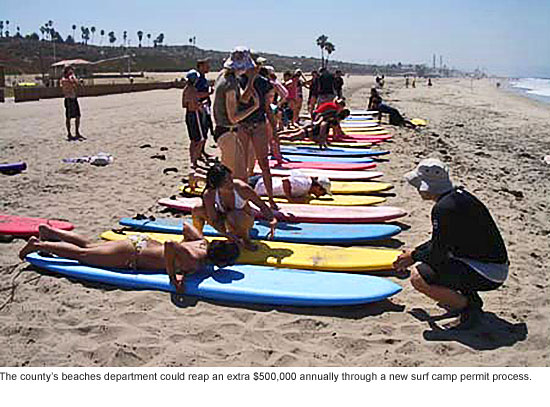 It started last summer in Malibu with a fight between surf camps and led through a black market to a legislative mystery.
It started last summer in Malibu with a fight between surf camps and led through a black market to a legislative mystery.
But the long, strange trip that this year led Santos Kreimann to the discovery of a mistake that was costing Los Angeles County hundreds of thousands of dollars is now offering the intrepid director of the Department of Beaches and Harbors a possible long-term fix for this summer’s first pressing problem: how to keep the beach bathrooms open and clean.
County beach maintenance workers came under fire last week in one of the more publicized sidebars to the county’s ongoing budget challenges. Amid complaints about scaled-back cleaning schedules, late openings and locked doors at the county’s 52 beach restrooms, Supervisors Zev Yaroslavsky, Gloria Molina and Don Knabe called for alternatives.
The discussion generated headlines and local talk radio furor. On Tuesday, Kreimann presented the Board with a short-term plan to delay some hiring and maintenance and to use marina lease-option and lease-extension fees to open more bathrooms earlier and beef up summer cleaning crews.
Less widely-known, however, was the story behind the long-term proposal Kreimann hopes will help pay for not only the bathroom maintenance, but for other beach services going forward: a change in the county’s longstanding permitting system for recreational beach camps.
At issue, Kreimann says, is the way the county allocates beach space to the hundreds of interest groups that do business on the sand each year, including legions of surf camps and summer recreational programs that traditionally have received permits according to seniority. 
For-profit programs are required to pay a small percentage of their gross receipts in exchange for the permits. That assessment, however, has been waived in past years for city-sponsored programs and non-profit organizations; they’ve paid only a modest administrative fee for the privilege of setting up shop on county beaches. “But there are non-profits, and there are non-profits,” says Kreimann. “Some of these camps charge like $600 a week.”
With public revenues dwindling, he says, those non-profit programs looked like an untapped source of revenue. But when Kreimann, who was appointed director in 2009, inquired about the issue, he was told by staffers who’ve since retired that the nonprofits couldn’t be charged because state law prohibited the county from assessing fees on youth groups.
Then last summer, he says, a surf camp in Malibu resurrected the beach permit question when its owner called to demand that an unpermitted rival be thrown off the sand. “The camp operators got into a physical altercation over allegations that one was operating illegally,” Kreimann says.
Allen King, co-owner of Aqua Surf camp, says the set-to was more like “harassment.” But he confirms that the dispute arose from the beach use permitting policy—in this case, the seniority system, not the fees.
As surf camps had proliferated in recent years, beach permits had become highly valuable, and anyone who had one was reluctant to relinquish it to make space for newcomers. When the City of Santa Monica, where King had operated for more than a decade, decided to decrease surf camp permits to reduce beach crowding, King says, he found it impossible to break into the county beach space.
“We tried to get a county permit, we wrote letters, but it was a closed system,” King says. “Whoever got one first would just hold onto it forever, and nothing moved.”
King’s solution: to cut a deal with a permitted surf camp. He says he offered to expand the business of Kanoa Aquatics, based in the South Bay, by setting up shop to the north, on Surfrider Beach in Malibu under Kanoa’s brand.
After a year, however, the relationship soured, according to both parties, and got downright ugly after King returned to Surfrider—without a permit—the next summer, setting up shop right next to the spot where Kanoa’s owner, Kip Jerger, was now operating on his own.
“I got a little personal,” Jerger acknowledges. “In a way I’m sorry but in a way I’m not. I was like, ‘You guys are like sharks coming in from the ocean.’”
King, meanwhile, says he was just “taking a stand” against an unfair permitting system, only to be confronted by his former colleague. “They were out there yelling, ‘You’re illegal! You’re not allowed to be here!’” King says. “You could have built a reality TV show around it, it was so dramatic. No one got into a fistfight, exactly, but someone did throw a rock at our tent, and we have witnesses.”
Kreimann of the beach department says that when the dispute landed on his desk, he felt compelled to revisit the permitting system. Clearly, beach use had to be limited, but the seniority system was creating problems of its own. Some 50 camps had been waiting years for a spot on one of the beaches, and existing permits had been issued and reissued “with no real safety standards.”
“Multiple people were subcontracting their permits,” he says. “A black market is a pretty good analogy.”
And, he learned, only about 30 of the 162 permit holders were paying a share of their gross receipts to the county because of the state legislation that supposedly prevented the county from charging nonprofits.
“So three or four months ago, I said to my staff person, Penelope Rodriguez, ‘Find that law.’ ”
She couldn’t.
Rodriguez, a program manager, says she quizzed colleagues and searched files and databases, but “we didn’t have the actual bill in any files and nobody remembered the year or the author or what group had introduced it.”
Finally, she says, she traced the confusion to a bill from the mid-1990s that had gotten through the legislature before the governor took issue with a provision that said youth groups not only shouldn’t be assessed like for-profit beach camps, but shouldn’t need the same liability coverage.
“It turned out that the law had been vetoed,” says Kreimann. “We should have been charging them all along.”
Kreimann says the faulty legal assumption was “an oversight” by otherwise hardworking employees, the last of whom retired earlier this year. “The actual law was right there in our file when we went back to check it, but they had misunderstood it. It was one of those things you discover when people leave and you get a new set of eyes.”
Since then, a plan to revamp the system and to set up a competitive selection process for summer permits, based on minimum standards set by the county lifeguards, has been working its way through a series of Beach Commission meetings. A workshop was held in early spring.
Jerger, who has had his beach permit for 14 years, says he understands the need to raise revenue—in fact, he works part-time for the county as a recurrent lifeguard. But he predicts a change in the system will let in more camps and worsen beach crowding, which, thanks to the stalled economy, is already at record levels. (According to the County Fire Department’s lifeguard division, attendance last year topped 68 million, nearly double the 38 million beachgoers counted in 2005-06.)
And levying a percentage of gross receipts on nonprofit recreational programs, he says, could force him to start charging the families of hundreds of disabled and needy children, to whom he’s been giving a break on tuition.
King, on the other hand, says he’s glad to ante up if it means getting a permit.
For his part, Kreimann says the assessment will not only add a measure of fairness and oversight to the beach camp landscape, but could net “in the neighborhood of $500,000 a year, conservatively.”
A recommendation is expected to come before the Board by the end of August. Kreimann says it’s too late for the plan to cover the estimated $372,000 it will cost to revamp the cleaning schedule for this year. But if consensus is reached, it could make the summer of 2012 more convenient and fragrant.
And any surplus could go toward Kreimann’s next plan for getting the most out of the county beaches: “A lot of our parking machines are down a lot of the time, and if we replace them, it could really increase revenue.”
Posted 6/7/11
Spring forward to summer camps in L.A.
April 7, 2011
 Summers can be a challenge for young families, but there are some great day camps and enrichment programs out there—if you register in the spring.
Summers can be a challenge for young families, but there are some great day camps and enrichment programs out there—if you register in the spring.
That’s the secret that Southern California parents often learn the hard way, usually as panic sets in a week or so before school ends. Fortunately, space is still available at many local day camps and enrichment programs, including some offered by Los Angeles County.
Here’s just a sample of L.A.’s many options. Sign up soon—summer will be here any day.
–Adventures in Nature Day Camp at the Natural History Museum of Los Angeles County is still open to kids from kindergarten to sixth grade between July 11 and August 12, from 9 a.m. to 3 p.m. Activities range from astronomy to trips to the La Brea Tar Pits. Kim Kessler, who is handling camp registration, says a few of the weeks are sold out for younger children, but most still have space—for the moment. Each week costs $250 per child for museum members, $300 for non-members. Click here to get your little nature lover in on the action or call 213-763-3348.
–The Los Angeles County Museum of Art’s popular summer art camp for children filled up within 24 hours after registration opened this year. But if your young artists are teenagers, they’re still in luck. LACMA offers four workshops for teenagers, and they still have openings. Weeklong classes run from 11 a.m. to 2 p.m. in digital photography, mixed media or painting. A month-long workshop focuses on building an art portfolio. Shorter workshops cost $200 a week for members and $225 for non-members. The longer workshop costs $650 for members and $750 for non-members. Click here for an enrollment form or enroll at the museum box office at 323-857-6010. Questions? Call 323-857-6139.
–There’s still room, for the moment, at the Los Angeles County Arboretum’s popular Summer Nature Camp, which offers full or half-days, with extended care starting at 8 a.m. and ending at 5 p.m. Kids aged 5-10 can plant trees, learn to cook from the garden, do arts and crafts, learn about bugs or just explore the Arboretum’s lush 127 acres in Arcadia. The camp runs in one-week sessions from June 3 through Aug. 12. Full-day sessions are $300 a week for members and $335 for non-members; half-day sessions are $150 and $168, respectively. Need more information? Click here or call Ted Tegart, youth education coordinator, at 626-821-5897. Or sign up at 626-821-4623.
–The Mountains Restoration Trust offers yet another day camp for little nature lovers in the Santa Monica Mountains, operated from the 1896 Calabasas farmhouse that now houses the non-profit’s nature center. Susan Haugland, project manager for youth programs, says the Discovery Nature Camp, for kids 8-12, is particularly hands on, with lots of cool guests speakers, field trips and appearances by skunks that can do the moonwalk. Hours are from 9 a.m. to 3 p.m. Monday through Friday, and a weeklong session costs $260. Enrollment is capped at 18 children per week, but registration just opened. Sign up at 818-591-1701 x212.
–The Dolphin Camp and other water awareness camps offered in the past by the county’s Departments of Beaches and Harbors were cancelled this year due to budget issues. But the Los Angeles County Junior Lifeguard Program is still alive and well, sponsored by the Los Angeles County Fire Department. The summer program, offered in half-day morning or afternoon sessions, instructs kids in ocean skills from swimming and surfing to water safety. It’s open to kids aged 9-17 who pass a swim test; pre-registration begins April 25 for the May 7 test in Manhattan Beach. The 5-week program starts June 27. Last year the fee for the summer-long program was $420, but a $56 increase is pending before the Board of Supervisors. For more information, click here or contact the Junior Lifeguard Office at 310-939-7214 or [email protected].
– Registration opens May 3 for the summer day camp at the county’s El Cariso Park in Sylmar, which is open to kids aged 6-12. The camp starts July 1 and lasts until the Friday before school starts in September and—working parents will like this—it goes from 7:30 am to 6 p.m., Monday through Friday. There’ll be field trips, arts and crafts, computer classes and outdoor playtime, plus swimming and sports fundamentals. The price is right, too: $65 a week, plus a $20 registration fee. Sign up at the park office next to Mission College at 13100 Hubbard St. in Sylmar, or call 818-367-7050.
– Want to make a movie? This summer, the William S. Hart Park and Museum and Los Angeles County Arts Commission will offer a free three-day filmmaking workshop for kids aged 10-17. Students will learn about filmmaking, theater, and storytelling, as well as the legacy of local silent film star William S. Hart, as they create their own silent film. The workshop will be taught by instructors from the Canyon Theatre Guild and the CalArts Community Arts Partnership. Space is limited and applications are required. Hours will be 10 a.m. to 2:30 p.m. on July 23, July 30, and August 6. For more information, call 213-202-5858.
–Does a short course in horn playing, tap dancing or classical piano sound fun? The Colburn School in downtown Los Angeles is offering summer camps in all three. The Colburn Academy Festival, a 2-week program, is limited to highly gifted young pianists, but the Tap Intensive, at the school’s downtown Studio B at 200 S. Grand Avenue is open to beginning, intermediate and advanced hoofers from 7-19 during the week of June 27-July 1. And the Horn Camp, a 4-day workshop, is open to horn players of all ages. Need more information? Call 213-621-1085 for the Tap Intensive, 213-621-4554 for the Horn Camp or click here for the piano program.
–The Hollywood Bowl doesn’t do camps, but it does offer a great summer outing for kids and parents (or day care providers) weekday mornings from July 5 to August 12. For just $7 per ticket, kids can watch a concert in the museum patio area, do some fine arts activities and make a morning of it. Or bring a picnic lunch and stay into the afternoon. The Summer Sounds Series will feature classical Korean music for the first two weeks, gospel music for the second two weeks and Irish dance and music for the final two weeks. Click here for more information. Tickets go on sale May 14.
Posted 4/7/11
Beach’s elder statesman looks back
March 10, 2011
 Edward Craig remembers waves so oil-polluted that he couldn’t swim without washing himself afterward with turpentine. He remembers beach crowds so environmentally careless that they blithely dumped their trash right onto the sand.
Edward Craig remembers waves so oil-polluted that he couldn’t swim without washing himself afterward with turpentine. He remembers beach crowds so environmentally careless that they blithely dumped their trash right onto the sand.
He remembers when surfers waxed their longboards with the paraffin their mothers used for canning. He remembers when women’s tank suits turned to bikinis and bikinis turned to thongs.
But ask the 70-year-old how many lives he has saved as Los Angeles County’s longest continuously serving lifeguard, and memory fails him. “Oh, my gosh,” he says. “Thousands.” Which makes sense, since Craig has been watching over local beach-goers every summer, without exception, for more than 50 years.
A retired teacher who for 38 years taught music in the Anaheim Union High School District, and who still supervises student teachers at Biola University, Craig has had a second career lifeguarding on weekends and summers since his late teens. County employment records show he was hired in May 1959 and has worked every summer since, including last summer. (One other recurrent lifeguard is older and has an earlier hire date, but records indicate that a medical issue sidelined him last year.)
“I’ve always liked the water,” says Craig, who grew up in Lennox and bicycled as a child down Imperial Boulevard to the ocean. “Riding on the waves as a body surfer, the ocean throwing you toward shore.”
Craig played water polo at Inglewood High School, El Camino College and Cal State Long Beach, and spent his childhood swimming and surfing in the South Bay. His favorite beach as a young man, he says, was the popular Manhattan Beach surf hangout known as El Porto; located near the Chevron oil refinery in El Segundo, its signature attraction is underwater—a deep fissure in the bay floor known as Redondo Canyon, which generates bigger-than-average waves on a consistent basis.
It also generates bigger-than-average crowds and bigger-than-average risks for swimmers—downsides that Craig would learn more about when, at 19, he became an ocean lifeguard. El Porto, which is still where he works most, ended up being his first professional post.
“On my first day on the job, I had 37 rescues,” Craig remembers. “People losing their boards, people stepping into rips. It was a pretty rough day.”
Does he remember the first swimmer he saved? “No,” he says, “but I do remember some amazing rescues over the years.”
There were the two exhausted swimmers he pushed for the length of three football fields on a surfboard to free them from a particularly vicious riptide.
There were the seven kids from Lawndale who ran full-tilt into the ocean, even though they could not swim and Craig had warned them to stay out of the water.
“I had two on the can, one by the hair, one in a cross-chest carry, one holding onto my foot, ” he remembers. “I was out there by myself—all the other guards were involved in other calls that day. Fortunately an older surfer came by and took the other two off my hands.”
Then there was the yellow Labrador who chased a stick into a riptide, leaving his anguished master ankle-deep in water, shouting the dog’s name helplessly at the waves. “The dog was way out there and really struggling—I could just see his nose barely sticking out of the ocean,” Craig remembers.
“I started swimming, wondering how in the world I was going to do this rescue. But when I swam up and I shoved my rescue can under his belly, he put his paws through the front handholds and they got stuck! I was able to drag him to shore, and the guy was so grateful, he came back to the tower with a case of beer the next day.”
Craig was glad, too: “I kept thinking, ‘What if I have to give this dog mouth-to-mouth?’”
Craig says the county’s beaches have changed substantially over the summers. For one thing, they are much cleaner and safer than they used to be.
“There was a lot more pollution. We’d often take a gallon of turpentine along to wash ourselves off after swimming. We’d paint each other down with a big paintbrush—you didn’t want to track that oil through your mom’s house. Also there was a lot of litter—you could look all up and down the beach and not see a trash can. And there was a lot more tar on the beach.”
Now, government regulation and environmental consciousness deter litterbugs and industrial polluters. “The beaches are meticulously cleaned,” Craig says. “We have four trash cans every hundred yards.”
And beach-goers are safer. Lifeguards are more professional, more numerous, better trained and stationed in lifeguard towers that are better equipped and closer together.
“Back in the ’60s, rescues were much longer distance because people would be pulled out farther,” Craig remembers. “Not because ocean conditions were different, but because there were so many fewer of us that by the time we got to them, they could be 50 yards offshore in a big boil. And there were no wave runners to help us out.”
Nor, for many years, was there much law enforcement, at least at El Porto. When Craig started, the beach was an unincorporated “county island” between Manhattan Beach and El Segundo. Packed end-to-end with little surf shacks arrayed along narrow alleys, El Porto was notorious in those early days for the bevies of airline stewardesses who bunked there and the surfers who populated its raucous bar scene. Until Manhattan Beach annexed the 34-acre area in 1980, the nearest authorities were 20 minutes inland at the sheriff’s Lennox substation, he says.
“We had one period in the mid-1970s where a group of armed Nazi surfers declared it their turf,” Craig remembers. “They’d throw things at people from the parking lot and shoot holes into the back of the lifeguard towers.” If someone at the beach was injured, he says, the paramedics of first resort were the lifeguards. Now, of course, El Porto is just another well-patrolled coastal neighborhood in sedate, pricey Manhattan Beach.
One thing that hasn’t changed much is the exceptional fitness required of county ocean lifeguards. Craig still vividly remembers his first lifeguard certification test.
“You swam around a buoy at the Hermosa Pier, and then south to the breakwater, then around another buoy and then back to the beach,” he recalls. “You did this in mid-April, so the water was still quite cold. It was a thousand-yard swim, not counting the 200 yards out and the 200 yards back in, and there were over 200 people, probably, the year I took the test.
“They took the top 25 across the line. I saw the mob going for the buoy and I thought, ‘Oh, my God.’ I was a decent swimmer, but it was daunting. The water was so cold, and the current so strong, and the wind so fierce that almost half the people had to be picked up or brought back in before they covered the first 200 yards.”
But Craig made it: “I was No. 11,” he remembers. “These things stick in your mind. “
Craig still takes the test every year, and still passes. “Obviously I’m not the fastest guy on the beach, but my average time is about 10 minutes, 30 seconds, depending on conditions,” he says.
His fitness regimen is not the average 70-year-old man’s daily workout. A 30-mile bike ride every Monday. An 80-lap swim on Tuesday, Thursday and Saturday. Two-miles of wind sprints on the beach, twice weekly. A 3-to-5-mile row in a single-man Dory twice monthly. On-duty workouts daily. Oh, and he still surfs two or three times a month.
“He’s the perfect waterman—an elder statesman of lifeguarding,” says Section Chief Terry Yamamoto of the County Fire Department’s lifeguard division, who has known Craig for three decades, since Yamamoto was a teenager hanging out at El Porto and Craig was the summer lifeguard there. Craig, he says, was one of a handful of lifeguards who mentored him into the profession. Among other things, Yamamoto says, Craig taught him “how to stay calm in all situations.”
“The older you get, the wiser you get in this job,” says Yamamoto. “You can almost predict how people are going to behave on the beach. It becomes instinctual, so that you can be where you need to be almost before something happens.
“We’ve been on literally hundreds of rescues together, and because he’s been on the job for so long, Ed tends to be there as quickly as the younger guys because he knows where he’s going to be needed.”
Nonetheless, Craig says, “this year will probably be my last.”
“I’ve never lost a swimmer,” he says, “and I still feel I could make any rescue I could see. But I’m getting to the point now where you try to be realistic about your career.”
Retiring from the lifeguard tower would give him more time for his music, his wife of 46 years and his two granddaughters; it might also make for some slightly less stressful summers. “Ninety percent of the job is sheer boredom and ten percent is sheer terror,” jokes Craig.
Still, he says, “I don’t think I’ll ever get tired of watching the water—the pelicans flying by, the surf, the sailboats, the ships offloading their supplies. It never changes, and yet it’s always different, always moving. It’s one of the fascinating things about the sea.”

El Porto Lifeguard Station
Posted 2/16/11




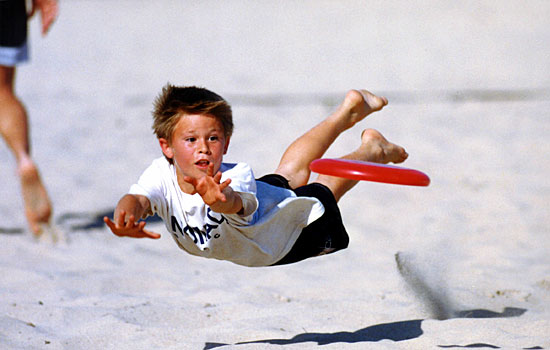
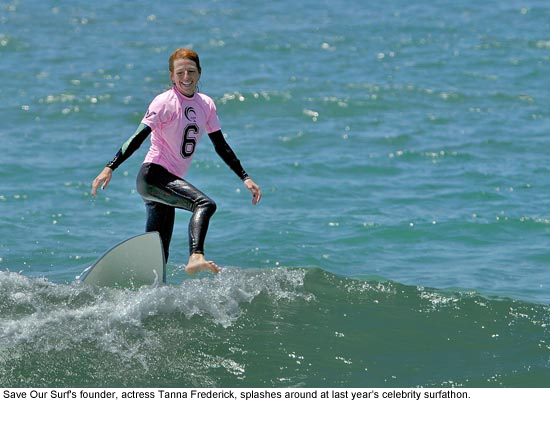
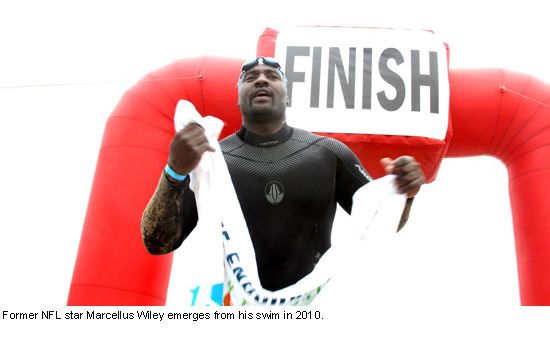
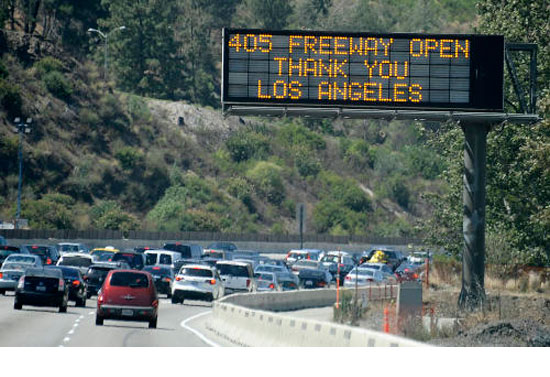


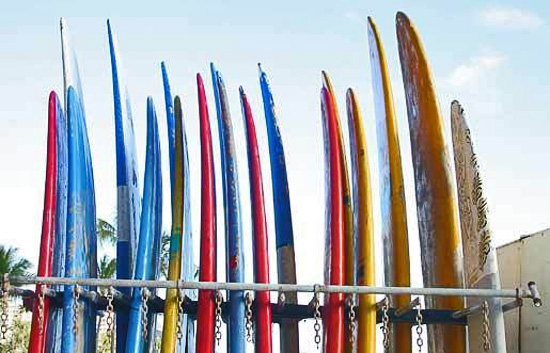
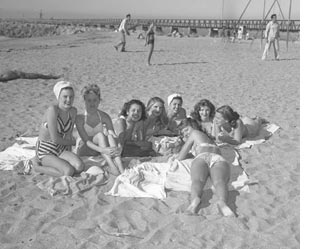








 405 bridge work causes a stink
405 bridge work causes a stink

